BCBC Spring Newsletter & Conference Review 2020
Message from the 2020 Chairman Clive Brown
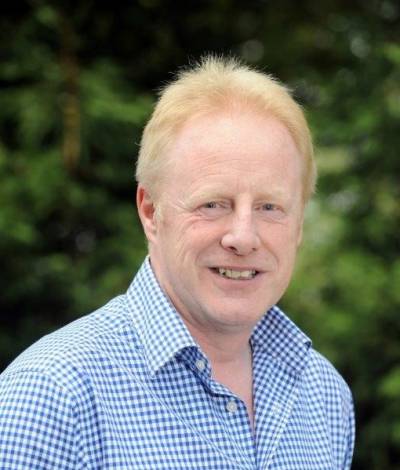
It is a great honour to have been elected as Chairman of the British Cattle Breeders’ Club for 2020 and I very much look forward to the year ahead.The recent British Cattle Conference in January was
again highly successful, insightful and provided much for the Club to move forward with. Thank you and congratulations on a job well-done to outgoing Chairman, Laurence Loxam and his committee and welcome to the new committee members, Tim Gue, Alex Brown and Ben Harman, who have joined the team. Work is already under way for the coming year, to ensure the BCBC continues to provide integration of science, technology and breeding in beef and dairy production.
Support for BCBC is drawn from a solid spread of farmers, researchers, industry and students. This demonstrates a wide understanding that the organisation has evolved and shown longevity in remaining relevant. Continuing to evolve will be essential so it is wise to learn from the past but more important to focus on the future. As the Club’s committee prepares for the forthcoming year’s events, we will be fully aware of this whilst recognising that we must retain the essential link to breeding. As we look to a future that not only expects high levels of production efficiency, but one that demands producers respond to a wider agenda of issues such as climate change, health and animal welfare, there is prudent reason for us all to examine whether the genetics we use at a herd or breed level are likely to deliver what supply chains require.
In developing the programme for the 2021 Conference, we will look to secure speakers who will be thought-provoking, inform ative and challenging, while promoting our strengths and encouraging discussion. I strongly believe this is a great time to be involved with breeding and genetics. We face some challenges, but with the speed of genetic change the UK cannot afford to be left behind. Although it takes 10 years for the full effect of breeding decisions to be seen at herd level, the way in which we make these decisions seems to change rapidly as new sciences emerge and develop. Making the most of the opportunities that these developments deliver, as well as keeping an eye on what consumers demand, will be critical if we are to maintain a viable livestock sector.
Farmers, researchers, students and the agricultural industry continue to support the BCBC engaging in lively discussions and embracing the opportunity to inform themselves of the latest developments in research, technology and best farming practices to enhance the future of UK cattle breeding and genetics. I would urge anyone with an interest in the UK cattle industry to join us – the annual Club fee is only £35 and offers discounts for our annual two-and-a-half day conference, access to the conference reports, talking slides, farm walks and a quarterly magazine – offering great value for money. I look forward to meeting and greeting you at our 2021 conference.
The Beef Day - Sustainability and profitable breeding were key themes highlighted during the beef day presentations
Dr Jude Capper - Going green; how do we communicate our industry's environmental advantages?
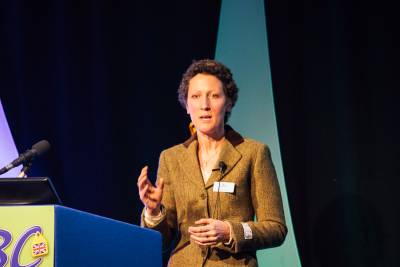
The UK livestock industry does pretty well with its carbon footprint compared with the rest of the world, but we do see huge variation within our systems, said Dr Jude Capper, concluding the lineup of speakers at the Beef Day. She explained that we have a huge opportunity to change and demonstrate to consumers the good work to be done.
This change can come about by improving our KPIs – feed efficiency, growth, fertility, longevity, maternal traits - which will then have a knock-on economic benefit. These KPIs work differently for different breeds on different systems/geography, but there is room for progress for all.
The livestock industry needs to have the consumers trust in what it does and what it produces. The way people receive information has now changed, with the days of the peer reviewed publications long gone and the vast majority of information available to the consumer now coming from people’s phones. About 82% of 16 to 24 year olds access their news/information from blogs and through social media, where the balanced nature of information can be called into doubt. It is important we keep meat and dairy products in the diet of this age group by providing short, simple messages with a few key facts and highlight the long tradition of farming.
Sophie Throup - Beef into the future: customer focus and a retail perspective
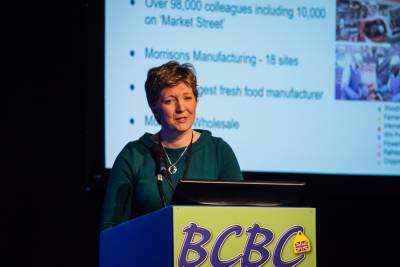
Sophie Throup, Senior Agricultural Manager at Morrisons, gave a retail perspective on developments in the industry, covering what was important to the consumer and how this is affecting the industry. While food safety is the number one priority for UK consumers, supporting British farmers was number two. Animal welfare continues to rise up the consumer agenda, moving to number four in the list.
The environmental movement continues to gather pace across all ages of consumer, with the offering of meat-free meals growing and overall meat sales falling compared to their 2017 level. Sophie explained that 94% of households eat meat and fish on a weekly basis; so people are still eating meat on a regular basis, but just less of it. Sophie acknowledged that the nutritional density of meat is a key part of the debate.
Roddy McLean - Supporting the Sector, The Challenges and Opportunities
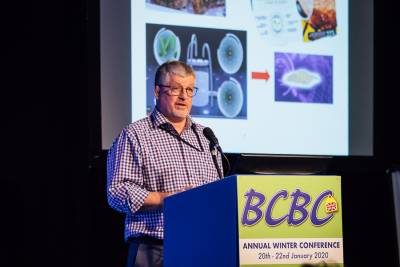
Research shows that when it comes to food, consumers want ‘trust, traceability and transparency’, according to Roddy McLean, Director of Agriculture, NatWest, who opened the Beef Day at the BCBC Conference. Although farmers are trusted by consumers, Roddy stated that farmers currently aren’t good at communicating their values and that taking part in activities such as Open Farm Sunday were key to helping showcase the best of British farming.
There are challenges facing farmers across the board, he stressed, and beef producers need to ensure that both their businesses and themselves, are ‘future fit’. He stressed the importance of budgeting and benchmarking, and then making use of this information to guide business decision making. Roddy also recommended that businesses ring fence quality time for the management team – be that with key staff and/or family members – to meet regularly and discuss an agreed agenda, with minutes taken, in order to a set a timeline for actions. He also suggested holding regular meetings with staff and making sure that business aims were effectively communicated to all employees.
Dr John Crowley - How heavy is too heavy?
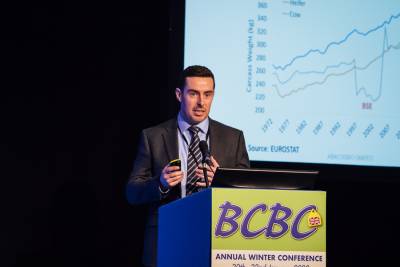
Dr John Crowley, from AbacusBio International Ltd, explained in his paper titled ‘How heavy is too heavy?’, that, for a typical UK beef farm, there is an optimum breeding female mature weight in the range of 680kg to 725kg for cows. This conclusion was drawn from research which modelled the beef production system in the UK; this model is dependent on a number of assumptions including the cost per unit of feed for heavy cows.
Dr Crowley’s research team compared the cost of producing cows with a mature weight of 651kg compared to those with a mature weight of 751kg. The model found that although heavier cows can result in higher revenue, they can also have higher production costs. This is because heavier cows need a higher ‘quality’, more energy dense feed, which increases the marginal feed cost. Heavier cows can also have slightly reduced fertility and require more land than lighter cows, resulting in a reduced stocking rate with heavier cows. These factors all combine to result in heavier cows having an increased cost of production which needs to be balanced alongside their higher revenue.
Considering this, Dr Crowley tells us the optimum breeding female mature weight is between 680-685kg, however this can increase to up to 725kg if no higher marginal feed costs are incurred. He also stressed that although it is important to focus on achieving optimum mature weight, this should not come at a cost to body condition score. Finally, he concluded that optimum mature weight is also heavily influenced by the penalties which are applied for over-weight progeny carcases.
Dr Bart Lardner - Developmental programming and alternative heifer development

What you feed your pregnant cows matters more than you think, said Dr Bart Lardner, who spoke about the impact of maternal nutrition during gestation on subsequent progeny. Dr Lardner, a Professor in the Department of Animal and Poultry Science at the University of Saskatchewan, explained that high fat diets over gestation resulted in heavier calves at birth and at finishing; suggesting this is possibly due to developmental programming. He also stressed the importance of knowing costs of production in any system and acting on this information.
Dr Lardner explained that his research centres around developing resilient replacement heifers for extensive grazing systems. They looked at how genotypes can be adapted to suit different environments. An example of this is exploring how dam nutrition can influence both the birth weight of calves and the finishing weight, as well as having an impact on heifer longevity. Dr Lardner explained that dams fed a high fat diet during pregnancy result in heavier calves both at birth and finishing. He also highlights the importance of ensuring your replacement program fits your type of operation, and that particular focus needs to be placed on reproduction and longevity.
Dr Michelle Judge - Breeding for superior beef meat eating quality
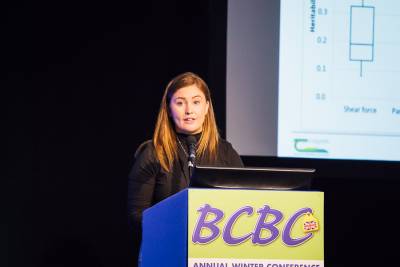
Have we reached a plateau in non-genetic improvements to meat eating quality and where will the next steps come? This was the question posed by Dr Michelle Judge, from Teagasc, Co Cork. Despite the extremely controlled conditions in abattoirs, large variabilities in meat quality persist and Dr Judge argued that genetics undoubtedly contribute to this variation.
Dr Judge went on to explain how meat is tested for tenderness, juiciness and flavour and that results show consumers preferred the meat from those sires classed as positive for eating quality. Ireland, which is the fifth largest exporter of beef in the world, needs consistent quality for these export markets and it will launch meat quality EBVs for AI sires with the hope of identifying superior sires.
Mike Powley - Building for the future, concrete and carbon
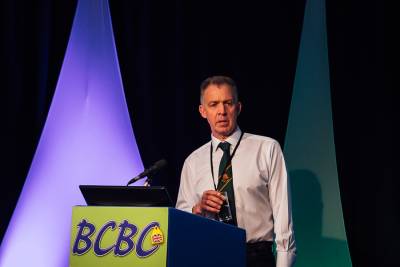
Suckler farmer Mike Powley, from Oak House Farm, Green Hammerton, Yorkshire, gave an update on the unique breeding programme at his farm and how he plans to make the farm sustainable for both animals and the soil.
Five years ago the decision was made to grow the business and Mike has concentrated on three key areas: infrastructure, genetics and soil. Previously, farm buildings were tired and too much time was taken moving feed and stock between various sites. A new unit has been built to provide the best accommodation for cattle, with a special focus on handling facilities.
When developing a unit that suits one man working with 150 cows, Mike is looking for docile, fertile, easy calving, long-living cows that will produce good quantities of high quality milk, as well as fast growing calves. He has been crossing his South Devons with Norwegian Reds to produce a great multiuse breed that fits his requirements well.
Another of Mike’s aims has been to rebuild topsoil at the farm by running a no till, minimal disturbance system. The rotation of three years red clover, two years of wheat, followed by a cover crop, spring beans and two years of arable has worked very well, as proven by the soils ability to absorb water this very wet season.
Ben Harman - Repeatable quality beef
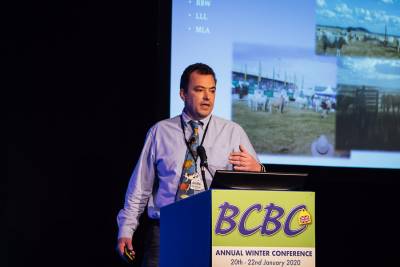
Ben Harman from Grove Farm, Chesham, Bucks, has developed a system of Chagyu (Charolais x Wagyu) beef that produces a repeatable, quality product that meets the needs of his customers. Farming on the urban fringe of London does have its drawbacks but also places him close to some very discerning customers.
The crossing of the two breeds brings the strengths of the Charolais breed (weight for age, quality, temperament and conformation) and the strengths of the Wagyu breed (docility, perception, marketing advantage and point of difference) into one product. Ben stressed that beef can’t compete on price with chicken and pork, so needs to have the quality to differentiate the product.
The Dairy Day - Genetic applications and succession planning were key themes covered during the dairy day presentations
Werner Brand and Dr Scott Denholm - Deep Learning and its application in the livestock industry
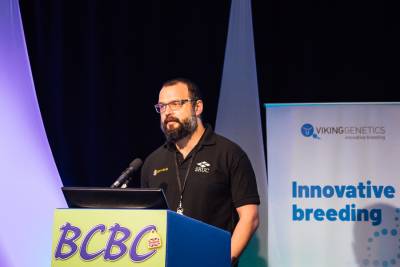
Werner Brand, Geneticist/Programmer from SRUC, opened Dairy Day at the BCBC Conference by explaining how deep learning can be used as a way of solving complex genetic problems. He discussed a project that is looking at predicting the pregnancy status of dairy cows using mid-infrared (MIR) spectroscopy data, routinely collected during milk recording. He stressed that this is not currently an alternative to conventional pregnancy diagnosis. However, it does offer a non-invasive method to continually monitor the progress of pregnancy and can be done as part of routine milk recording.
Werner also highlighted the wider opportunity which deep learning offers the livestock sector. He notes that the technology has been available for over ten years but there has been limited uptake in agriculture. Although this is beginning to change, with several new projects exploring areas including: cow facial recognition, udder classification, and genomic evaluations. What all these projects have in common is the potential to automate repetitive on-farm tasks, meaning that in the future deep learning could have a positive impact on the use of labour on farms.
Deep learning provides a powerful tool, but Werner stresses its reliance on quality data. Ultimately this will be key to ensuring its successful use in the agricultural industry. He reminds farmers that collecting, recording, and storing good data is important, especially if they want to utilize deep learning technologies in the future. Although deep learning may have some way to go before it is common-place on farm, there is certainly potential for it play a role in agriculture in the future.
Werner’s colleague, Dr Scott Denholm, also spoke about the application of deep learning in predicting the TB status of dairy cows using their MIR spectral profiles as part of routine milk recording.
Further research is needed but results are very promising, with early diagnosis contributing to a reduced length of a TB breakdown.
Neil Eastham - Future-proofing your herds through the use of genomics
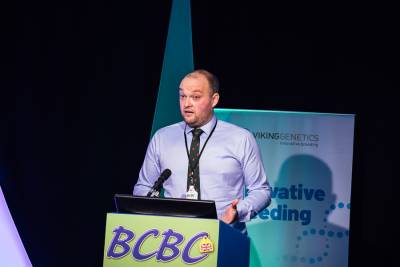
Vet and Nuffield Farming Scholar Neil Eastham spoke about the benefits of genomics and how they can help ‘future proof’ UK dairy herds. He stressed that farm specific breeding objectives, combined with selection criteria and breeding strategies, were crucial to maximise genetic gains and financial returns.
He explained that faster genetic gain can be realised with genomics and that the targeted use of the best young genomics bulls was a good tool. Female genomic data can be used to drive decision-making - who to breed from and who to put beef to. Animals can be ranked according to the selection criteria in line with the herd’s breeding objectives and there must be scope to deselect the worst animals to realise a return on investment of genomic testing.
The use of sexed dairy and conventional beef semen, together with the sale of surplus low genetic merit heifers, is likely to yield the greatest results with genomics.
Gavin Tait - InVitro Embryo Production for cattle breeders
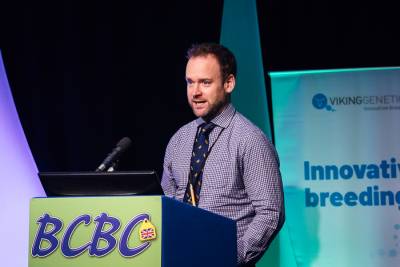
Veterinary surgeon Gavin Tait, from AB Europe, spoke about the practicalities of InVitro Embryo Production (IVP) and gave some practical advice for farmers thinking of using it. He discussed the advantages of IVP, which include: reduced handling of the animal, quick collection, semen flexibility, a quicker turnaround and the potential to collect from pregnant animals up to 12 weeks into gestation.
Gavin spoke about the importance of donor management when looking at factors affecting IVP success. The eight weeks prior to collection have a huge effect on the health and viability of the embryo. Donor cows also need to be not too fat or too thin and on a rising plain of nutrition. He stressed that not all semen was good quality and that quality can vary hugely between different batches from the same bull.
Looking to the future Gavin says they are keen to encourage clients to collect from better donors where possible. An ovarian ultrasound screening can be used to select better donors as it gives a fair idea of how she will perform and whether she will be a good candidate for stimulation or weekly collections.
Rob Hitch - Delivering succession for farming businesses
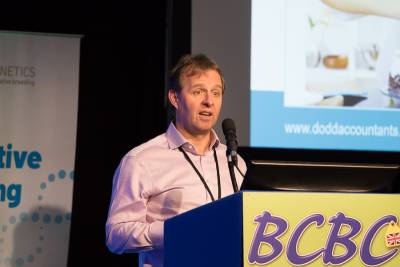
Succession in a farming business needs to be about finding the key person or people that have the skills and desire to take the business forward, said Rob Hitch, Partner at Dodd & Co Accountants in
Carlisle. Today’s farmers need many skills to succeed and not everyone will have them. Succession planning shouldn’t be driven by the issue of tax. It has to be taken into account but shouldn’t be the
driving force behind decisions.
It tends to be the younger generation that drives succession planning in a farming business. When younger members in the business meet a partner and have their own children and increase their responsibilities that the push comes for some type of succession plan.
It’s important to be honest about how much money is being made in a business. Don’t encourage someone to stay at home for ‘beer and petrol money’ if the business can’t support them on a living wage long term, he said. Splitting the business from the assets can make succession easier.
When things are split, they don’t need to be equal, but they do need to be fair, he added. Value can also depend on timing. Having value out of a business when someone is young and starting out can be more valuable than realising that asset later in life, he stressed.
Patrick Morris-Eyton - Improving sustainability for the future
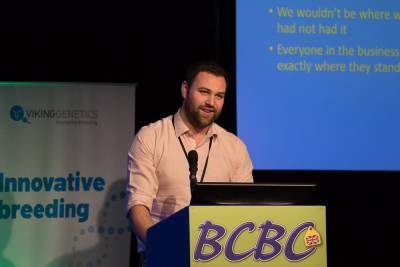
Dairy farmer Patrick Morris-Eyton farms in partnership with his parents and grandmother at Beckside Farm, milking 350 dairy cows (average yield 10,400 litres), with plans to increase the herd size to 400.
The farm also includes a herd of 800 breeding ewes, a construction business and an 87 KW hydroelectric scheme.
He spoke about the recent expansion programme at the farm, which included the construction of a new 54-point rotary parlour and cow housing, and how he is future-proofing the business by improving the sustainability of the farm. Patrick stressed that key to this has been increased efficiency on farm to drive profit, reduce carbon emissions and a better work life balance for partners and staff.
Addressing succession on the farm when Patrick was 24 allowed a plan to be put in place and the farm to develop accordingly. He feels it is important for everyone in the farm business, including partners, family members and staff to know where they stand.